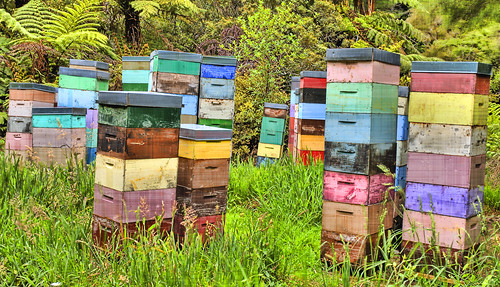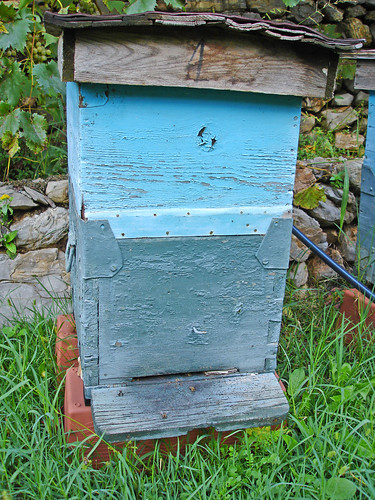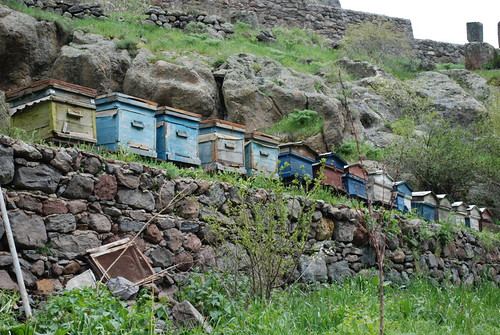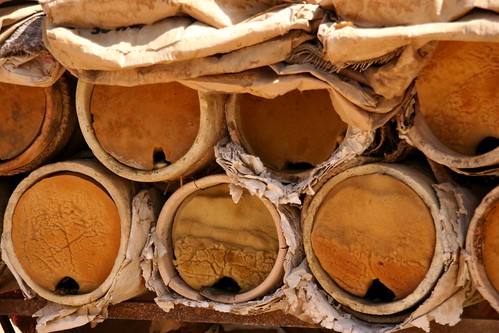| Ancient beehives. Great article on a new discovery of Bible era apiaries from the Jerusalem Post |
Friday, July 30, 2010
Ancient Beehives Discovered
Thursday, July 29, 2010
Beehives of the world
 |
| Beehives in China near where the earthquake struck. Hollow logs covered with slate to keep them from the elements. |
 |
| This is the modern type of bee hive used in Cameroon called a Kenyan Top Bar. The other kind is like an artificial hollow log made from bamboo-- kind of like Winnie the Pooh. And all of the bees here are African Killer Bee |
 | ||
| Beehives from the north island of New Zealand. |
 | |
| Museum of Folk Architecture and Rural Life. Pyrohiv, Nr Kyiv. Over time historical buildings have been brought here from all over Ukraine to live the communal life of an open-air museum. The space is split into the regions of Ukraine so that the buildings are grouped by geographic origin. The beehives where used as such in the past, disused now. They have been brought from Volyn' a province in Western Ukraine. They are made from the trunks of trees and each one is slightly different; different trees lend themselves to different effects. Some of them are decorated, carved or have thatched rooves. Each trunk would have a section cut out which is used to hollow out the trunk and then the outer piece is refitted as a sort of 'door' into the inside. |
 |
| Beehive. |
 |
Beehives - Geghard Monastery - Armenia |
 |
| Yemen |
 |
| Siberia. A nice cushion to keep them warm. |
 |
| Mobile beehives in Slovenia. |
 |
| More individually painted hives from Slovenia. Your Beeswax: More Beehives from around the world |
Genetically modified crops and their role with honeybees.
I came across a wonkish study that looked into the interactions of GMO's and honeybees. As with many other suspects of colony collapse, it showed some very real characteristics that could be contributing to CCD but still not exactly a smoking gun, just another piece in the puzzle of an unhealthy environment for pollinators.
The protein that is in BT crops (crops genetically altered to be poisonous to "pests") causes potential learning disabilities of bees that slows down the ability of the hive to be fully productive and forage effectively.
Of course none of these findings aren't anything a well paid corporate lawyer couldn't find enough holes in to drive a semi-truck of GMO corn syrup through. Tobacco attorneys were just as effective at avoiding empirical evidence and dragged litigation out for decades until a national settlement.
That is the nature of the problem, being that there are so many variables and no smoking gun, proving beyond a shadow of a doubt is nearly impossible.
GMO's also have the problem of being in the DNA of crops, DDT was found to be harmful and eventually was taken off the market. Extracting a piece of genetic code does not come off of store shelves, like DDT could be take off the market. GMO's have their place, increasing protein contents of crops for impoverished countries can very well be a net positive. If crops could be made to grow with partial sea water irrigation that could be a net positive for many countries in the world. All that being said, opening a Pandoras box by purposely making crops poisonous should treated much more judiciously. Getting a GMO crop out of the environment when turns out to be hazardous is like putting toothpaste back in the tube.
How do you undo DNA?
The original abstract:
The protein that is in BT crops (crops genetically altered to be poisonous to "pests") causes potential learning disabilities of bees that slows down the ability of the hive to be fully productive and forage effectively.
Of course none of these findings aren't anything a well paid corporate lawyer couldn't find enough holes in to drive a semi-truck of GMO corn syrup through. Tobacco attorneys were just as effective at avoiding empirical evidence and dragged litigation out for decades until a national settlement.
That is the nature of the problem, being that there are so many variables and no smoking gun, proving beyond a shadow of a doubt is nearly impossible.
GMO's also have the problem of being in the DNA of crops, DDT was found to be harmful and eventually was taken off the market. Extracting a piece of genetic code does not come off of store shelves, like DDT could be take off the market. GMO's have their place, increasing protein contents of crops for impoverished countries can very well be a net positive. If crops could be made to grow with partial sea water irrigation that could be a net positive for many countries in the world. All that being said, opening a Pandoras box by purposely making crops poisonous should treated much more judiciously. Getting a GMO crop out of the environment when turns out to be hazardous is like putting toothpaste back in the tube.
How do you undo DNA?
The original abstract:
Does Cry1Ab protein affect learning performances of the honey bee Apis mellifera L. (Hymenoptera, Apidae)?
Instituto de Ecologia A.C., Km. 2.5 Carretera Antigua a Coatepec No. 351 El Haya, 91070 Xalapa, Veracruz, Mexico.Abstract
Genetically modified Bt crops are increasingly used worldwide but side effects and especially sublethal effects on beneficial insects remain poorly studied. Honey bees are beneficial insects for natural and cultivated ecosystems through pollination. The goal of the present study was to assess potential effects of two concentrations of Cry1Ab protein (3 and 5000 ppb) on young adult honey bees. Following a complementary bioassay, our experiments evaluated effects of the Cry1Ab on three major life traits of young adult honey bees: (a) survival of honey bees during sub-chronic exposure to Cry1Ab, (b) feeding behaviour, and (c) learning performance at the time that honey bees become foragers. The latter effect was tested using the proboscis extension reflex (PER) procedure. The same effects were also tested using a chemical pesticide, imidacloprid, as positive reference. The tested concentrations of Cry1Ab protein did not cause lethal effects on honey bees. However, honey bee feeding behaviour was affected when exposed to the highest concentration of Cry1Ab protein, with honey bees taking longer to imbibe the contaminated syrup. Moreover, honey bees exposed to 5000 ppb of Cry1Ab had disturbed learning performances. Honey bees continued to respond to a conditioned odour even in the absence of a food reward. Our results show that transgenic crops expressing Cry1Ab protein at 5000 ppb may affect food consumption or learning processes and thereby may impact honey bee foraging efficiency. The implications of these results are discussed in terms of risks of transgenic Bt crops for honey bees.
More Mead Basics.
More information can be found here about mead making. The process is simple and good honey normally results in a very nice mead.
The Quick Guide to Making Mead
The Quick Guide to Making Mead
Posted by
Squidward
0
comments
Wednesday, July 28, 2010
Just like Mother Nature intended?
Spring time in an almond orchard is just starting to bloom. Bees are needed to pollinate thousands upon thousands of acres annually. As a thought experiment, would you suppose that you would see one species of tree over a square mile. Even if there is such a forest, it would still have diversity in the underbrush , natural pollinators would have habitat to live in and a variety of blossoms to forage. Grass and almond blossoms don't give the bees much variety for pollen, nectar the tree resins that they bring into the hive. Most people would get sick if they only ate one type of food three meals a day. I take it bees aren't much different and can have their immune systems compromised without a balanced diet.
Below is a Florida orange grove from a satellite, it covers square miles. The lessons that improved agriculture and expanded production pulling us out of the dark ages was that of crop rotation and avoiding monoculture. The corporate mantra of economies of scale is running head long into the laws of nature. Eventually we will have to rethink the nature of our food supply, forced or willingly. Replicating the systems and patterns found in nature will help solve the problems but are not as sexy and easily sold as a GMO or new pesticide that improves crop yields by X%. The economic model needs to change to saving on costs of fertilizers, chemicals and seeds from maximizing production per acre and national distribution. Smaller yields can be offset by shorter shipping distances and a diversity of produce that prevent their ever being a failed crop because there is always a successful crop elsewhere on the farm that the farmer has available to sell.
View Larger Map
Another Pesticide to add to the suspects list for Colony Collapse Disorder: Fipronil
I came across a good piece on a common pesticide that has been known for a while as a contributor to CCD. Again, it is not a single cause to solve the problem if we just eliminate it. The methods of industrial corporate agriculture are the root cause of CCD. Modern agriculture has been so far divorced from what occurs in nature that there has been collateral damage in the ecosystem.
Original text from here
Original text from here
"In sublethal doses, however, research has shown that imidacloprid and other neonicotinoids, such as fipronil, can impair honeybees' memory and learning, as well as their motor activity and navigation. When foraging for food and collecting nectar, honeybees memorize the smells of flowers and create a kind of olfactory map for subsequent trips.
However, in laboratory and field studies, honeybees exposed to imidacloprid seem to wander off, which may explain, say scientists, why hives all over the world are turning up empty.
Recent studies have reported on the "anomalous flying behavior" of imidacloprid-treated bees where the workaholic insects simply fall to the grass or appear unable to fly toward the hive.
In 2003, a French television documentary team filmed honeybee activity after exposure to imidacloprid. Clumsy and uncoordinated, their legs trembling, the bees looked like drunks unable to find the key to the front door of their hive. Others had trouble leaving the hive, seemed disoriented, and when they were eventually able to make their way out, soon disappeared, never to return.
The possibility that neonicotinoids are at the heart of the bee die-off implies a far more complex problem because of the widespread use of pesticides. Every year these chemicals are applied to hundreds of millions of acres of agricultural lands, gardens, golf courses and public and private lawns across the United States. Their use on major crops nearly tripled between 1964 and 1982, from 233 million pounds to 612 million pounds of active ingredients. And since then, their use has exploded. By 1999, the U.S. Environmental Protection Agency reported 5 billion pounds of pesticides used on U.S. crops, forests, lawns, flowers, homes and buildings.
Because of imidacloprid's emergence as a primary player in pest management, a painful paradox has developed in relation to the recent debate. Neonicotinoids are needed by farmers and growers to maintain the health of crops, many of which also require pollination by honeybees.
"Neonicotinoids are now the best aphid insecticide we have," said Peter Shearer, a specialist in fruit tree entomology with the Rutgers Agricultural and Extension Center in Bridgeton, N.J. "It's very important to our pests that have shown resistance to other chemicals. It's very important to eggplants, potatoes, tomatoes."
Shearer notes that apple farmers, for instance, don't use Provado, which has imidacloprid as an active ingredient, until after the bees, which are used for pollination, are removed from the orchards.
So it doesn't seem to be a logical route of bee die-off," he said. "It would have to last 11 months."
However, Shearer also acknowledges that some published studies indicate that imidacloprid can persist on both vegetation and in the soil for weeks, months and perhaps years.
In France, there have been inconsistent results since the bans on imidacloprid went into effect. In 2005, for the first time in a dozen years, the French honey harvest improved, but only in certain regions, according to the country´s beekeeping federation.
Some U.S. entomologists, who recently have been analyzing dead bees, have found a remarkably high number of viruses and fungal diseases in the carcasses, leading them to suspect there may be other culprits besides neonicotinoids.
A 2004 University of North Carolina study, for instance, found that some neonicotinoids, in combination with certain fungicides, increased the toxicity of the "neonics" to honeybees a thousand-fold.
"I don't think there is one smoking gun," said Hayes. "When neonicotinoids are used on termites, they can't remember how to get home, they stop eating and then the fungus takes over and kills them. That's one of the ways imidacloprid works on termites - it makes them vulnerable to other natural organisms. So if you look at what's happening to honeybees, that's pretty scary."
Last week the five-state Mid-Atlantic Apiculture Research and Extension Consortium released a progress report on colony collapse disorder. Its findings included "the high prevalence of fungi in adult bees" which seemed "indicative of stress or a compromised immune system; these symptoms have never been previously reported."
Another entomologist at the Rutgers center, Gerald Ghidiu, knows there is no simple answer to the problem.
They've been looking at this since the late 1990s," said the vegetable specialist. "They've done quite a few studies and they still can't find the direct link. Seventy-five percent of the vegetable crops in Arizona gets imidacloprid, but they have no problems with the honeybees right now. So why isn't it straight across the board? Everyone is in the dark over this."
Tuesday, July 27, 2010
KPBS piece on CCD
A well done piece on CCD talking about the multiple causes that may be responsible for it.
http://www.kpbs.org/audioclips/9754/
The original article is here.
"If they are treated with sub-lethal doses of pesticide, they actually will not come back to the nest, they may get lost. and one study suggests they actually will dance less," explained Nieh. "So their efficiency at recruiting other bees to that same food source is decreased and the colony is getting less food into it."
This is a troubling point. Being sub-lethal it is difficult to diagnose; hard to track down the source and just as difficult to be able to do something about it. The toughest part of solving this aspect of the problem is trying to get the pesticide or pesticides off the market. How do you prove a specific pesticide with a billion dollars in sales is doing this if you can hardly prove that it is lethal. Professional "scientists" on the corporate dole can easily find reasonable doubt on any specific pesticide and lay blame on another cause, this same strategy was effectively used by the tobacco industry for years.
http://www.kpbs.org/audioclips/9754/
The original article is here.
"If they are treated with sub-lethal doses of pesticide, they actually will not come back to the nest, they may get lost. and one study suggests they actually will dance less," explained Nieh. "So their efficiency at recruiting other bees to that same food source is decreased and the colony is getting less food into it."
This is a troubling point. Being sub-lethal it is difficult to diagnose; hard to track down the source and just as difficult to be able to do something about it. The toughest part of solving this aspect of the problem is trying to get the pesticide or pesticides off the market. How do you prove a specific pesticide with a billion dollars in sales is doing this if you can hardly prove that it is lethal. Professional "scientists" on the corporate dole can easily find reasonable doubt on any specific pesticide and lay blame on another cause, this same strategy was effectively used by the tobacco industry for years.
Friday, July 23, 2010
Basic Mead Making
The recipe I started out with was found here. I always thought cranberry and honey complimented each other. The pure unsweetened cranberry juice was about as pricey as the honey would be. Even with the "toddler of the house" monkeying with the air lock, I had very good results after about a year. I used more honey and didn't bother with the corn sugar. Typically the better the honey the better the end product. Don't a medal winning mead with bulk honey for baking that would avoid eating raw on toast or in tea.
Here is a basic run through of mead making and basic equipment.
More of the series can be seen here.
Let's Start out with the simplest three recipes:(5 gallon)
Dry Mead
* 12 lbs. of Honey
* 4 gallons of spring water
* 2 teaspoons of yeast nutrient
* 2 teaspoons of yeast energizer
* 2 packets of Lalvin 71b-1122 yeast (or a suitable replacement)
Medium Mead
* 15 lbs of Honey
* 4 gallons of spring water
* 2 teaspoons of yeast nutrient
* 2 teaspoons of yeast energizer
* 2 packets of Lalvin 71b-1122 yeast (or suitable replacement)
Sweet Mead
* 18 lbs of Honey
* 4 gallons of spring water
* 2 teaspoons of yeast nutrient
* 2 teaspoons of yeast energizer
* 2 packets of Lalvin 71b-1122 yeast (or suitable replacement)
These three recipes are the simple and no problem way to make a basic and great tasting mead. The only difference between them is the amount of honey you put into the must.
Here is a basic run through of mead making and basic equipment.
More of the series can be seen here.
Let's Start out with the simplest three recipes:(5 gallon)
Dry Mead
* 12 lbs. of Honey
* 4 gallons of spring water
* 2 teaspoons of yeast nutrient
* 2 teaspoons of yeast energizer
* 2 packets of Lalvin 71b-1122 yeast (or a suitable replacement)
Medium Mead
* 15 lbs of Honey
* 4 gallons of spring water
* 2 teaspoons of yeast nutrient
* 2 teaspoons of yeast energizer
* 2 packets of Lalvin 71b-1122 yeast (or suitable replacement)
Sweet Mead
* 18 lbs of Honey
* 4 gallons of spring water
* 2 teaspoons of yeast nutrient
* 2 teaspoons of yeast energizer
* 2 packets of Lalvin 71b-1122 yeast (or suitable replacement)
These three recipes are the simple and no problem way to make a basic and great tasting mead. The only difference between them is the amount of honey you put into the must.
Posted by
Squidward
0
comments
Thursday, July 22, 2010
Plans for your own Top Bar Hive
How to Build a Top Bar Hive
More info on building your own top bar hive from scrap wood you may already have. The simple practical design is perfect for the backyard beekeeper.
More info on building your own top bar hive from scrap wood you may already have. The simple practical design is perfect for the backyard beekeeper.
Wednesday, July 21, 2010
Building Top Bar Hives
Top bar hives are becoming very popular for hobbyist beekeepers. The design replicates the bees natural environment better than commercial hives. The hanging combs help prevent mites, the mites are unable to climb back onto the combs when they fall off. Eliminating mites eliminates the bees being exposed to the diseases that mites spread.
For the do-it-yourselfer here are instructions to build your own top bar hive.
For the do-it-yourselfer here are instructions to build your own top bar hive.
Pesticide and Colony Collapse Disorder.
I came across this article the other day. I have my doubts that there is any single culprit causing colony collapse but I have always figured that pesticides are a large part of the puzzle.
Insecticide suspected in bee Colony Collapse Disorder
FALMOUTH, Maine (NEWS CENTER) -- We need bees to pollinate our plants. But bees are disappearing.
Colony Collapse Disorder is name that has been given to the sudden disappearance of bee colonies.
The bees are getting disoriented for some reason. They can't find their way back to the hive and they eventually die. Some scientists now believe the bee disorientation could be due to a pesticide called Imidacloprid, a synthetic nicotine used in pesticides. Paul Tukey's group, Safelawns.org is asking people to avoid pesticides that include Imidicloprid.
There are many organic alternatives in pest control now on the market. One of Paul's favorites is Eco-Smart. The active ingredients are peppermint, cinnamon and sesame seed oils. All are considered food grade, and safe.
Paul says you still want to read the labels of the organic products and use the proper protection.
original article here
Insecticide suspected in bee Colony Collapse Disorder
FALMOUTH, Maine (NEWS CENTER) -- We need bees to pollinate our plants. But bees are disappearing.
Colony Collapse Disorder is name that has been given to the sudden disappearance of bee colonies.
The bees are getting disoriented for some reason. They can't find their way back to the hive and they eventually die. Some scientists now believe the bee disorientation could be due to a pesticide called Imidacloprid, a synthetic nicotine used in pesticides. Paul Tukey's group, Safelawns.org is asking people to avoid pesticides that include Imidicloprid.
There are many organic alternatives in pest control now on the market. One of Paul's favorites is Eco-Smart. The active ingredients are peppermint, cinnamon and sesame seed oils. All are considered food grade, and safe.
Paul says you still want to read the labels of the organic products and use the proper protection.
original article here
Subscribe to:
Posts (Atom)

